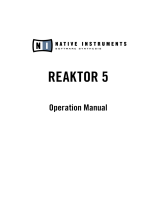Page is loading ...

!
[ OPERATION MANUAL ]!

Elements G-Delay
Welcome!
Thank you for purchasing Elements G-Filter.
G-Delay is the definitive dynamic grain-delay device. It combines an all-new granular engine
(featuring frequency, pitch, and spray controls) with an assignable envelope follower, which
can be plugged into any of the main parameters. We've then rounded it off with a couple of
filters, and all the CV connectivity you'd care to throw a rock at.
The result is a streamlined, yet highly versatile tool, which is particularly suited to special
effects, mind-expansion, and establishing communication with manifestations of Jungian
archetypes.
Typical applications include:
- Granular mono/stereo delay effects!
- Dynamic delay effects!
- Pitched and arpeggiated delay effects!
- Gritty, evolving textures and soundscapes!
- Otherworldly builds and drops!
- Talking to dolphins (requires isolation tank, sold separately)
We hope you have as much fun using it as we did creating it. Enjoy!
About Elements
Elements is a series of mini devices originally derived from our Triad Multiband series. They
have been carefully crafted to isolate and enhance specific “elements” of Triad, and integrate
together modularly, through stereo CV modulation and slick, unified design. A-Filter is part of
a new wave of entirely new devices not derived from Triad. "
AirRaid AUDIO
Page of 1 5

Elements G-Delay
Contents
Loading and saving patches
Loading and saving patches in G-Filter is done in the same way as with any other Reason
device. See “Loading patches” and “Saving patches” in the Reason Operation Manual for
further information.
Front controls and displays
ENV FOLLOWER!
The Envelope Follower generates a control signal from the device's audio input which can be
applied independently, either positively or negatively, to the Time, Feed, Freq and Pitch
controls. This signal can be “smoothed” using the Attack and Release controls.
Amp — Controls the amount of envelope modulation applied to the destinations specified by
the individual Envelope Mod Target toggle buttons.
Attack — Controls the attack of the envelope. Higher settings result in a slower attack,
whereas lower settings are much faster.!
Release — Controls the release or decay of the envelope. Higher settings result in a slower
release, whereas lower settings are much faster.
Envelope Mod Targets — Located to the right of the three knob controls listed above,
these buttons toggle whether the envelope modulation gets applied to their respective
targets. Eg. activating the Feed button ensures that the envelope modulation gets applied to
the Feed parameter, but not to the Time parameter.
Welcome! 1
Loading and saving patches 2
Front controls and displays 2
Env Follower 2
Delay 3
Global 4
Rear controls 4
CV Modulation 4
Audio I/O 5
AirRaid AUDIO
Page of 2 5

Elements G-Delay
DELAY
A-Filter’s analog filter is an insanely squelchy dual filter with 8 varied filter types. By “dual filter”
we mean, of course, that certain filter types in fact combine two filters in series or parallel and
allow their respective frequencies to be offset, creating a vast range of possible tones. With
each control being assignable to the envelope follower, A-Filter is the tool par excellence for
adding instant analog charm to any sound.
Time L — Sets the delay time of the Left channel. This time can either be synced or free,
depending on the setting of Sync. Synced times range from 1/64 to 1 bar, while free delay
times range from 10ms to 1000ms. Note: if the Stereo button is active, Time L controls both
the left and right delay times in tandem.
Time R — Sets the delay time of the Right channel. This time can either be synced or free,
depending on the setting of Sync. Synced times range from 1/64 to 1 bar, while free delay
times range from 10ms to 1000ms. Note: if the Mono button is active, Time R ceases to have
any effect as the right delay time becomes linked to the left.
Feed — Controls the feedback level of the delay. Feedback can either be positive or
negative, depending in which direction this bipolar knob is turned.
Freq — Controls the grain delay engine’s grain frequency (ie. the number of grains produced
in a single second). Values range between 1 and 150 Hz.
Pitch — Controls the pitch of each individual grain, allowing for delays whose pitch cascades
upwards or downwards (depending on the value of this parameter and on the feedback
level.) Values range between -24 and +24 semitones.!
!
Tip: Setting the delay time to the bare minimum, the feedback level to zero and the grain
frequency to a fairly low value effectively turns G-Delay into a real-time granular pitch shifter
whose pitch can be controlled via this knob.
Spray — Adds a progressive amount of randomness to the delay time of each individual
grain. The default setting of 0% adds no randomness, giving a perfectly clean delay signal,
and 100% gives the maximum amount of randomness, resulting in a chaotic “spray” of
sound.!
!
Tip: This control is great for completely disintegrating your audio signal on the fly.
Sync — Syncs the Left and Right delay times to the song’s tempo.
Mono — Links the Right channel’s delay time to the Left channels delay time, !
disabling Time R. Enabling this button will result in mono delay, whereas disabling it will create
a stereo delay (so long as Time L and Time R are set to different values).
AirRaid AUDIO
Page of 3 5

Elements G-Delay
Note: By “mono delay”, we do not mean that the outputted audio signal will be mono, as no
summing takes place, only that the delay times of the Left and the Right channels will be
identical.
Equal — Ensures that the Left and Right channels’ feedback times are equal, regardless of
each one’s individual settings. For example, a Left channel delay of 1/4 would logically decay
earlier than its 1/3 Right channel counterpart, which is not always desirable, and enabling
Equal resolves this.
HP — Controls the cutoff frequency of the high-pass filter that lies within G-Delay’s feedback
loop. Values range from 50 Hz to 20 kHz.
LP — Controls the cutoff frequency of the low-pass filter that lies within G-Delay’s feedback
loop. Values range from 50 Hz to 20 kHz.
GLOBAL!
Mix — Controls the dry/wet mix of the device.
Vol — Controls the volume level of the device’s output, allowing you to either attenuate it or
boost it by up to 6 decibels.
Rear controls
CV MODULATION!
As with most other devices in our Elements series, G-Delay offers two distinct types of CV
modulation depending on the parameter in question.
Some parameters allow for monophonic CV modulation, whereby the CV input modulates the
parameter for the left and right audio channel in an identical manner. Essentially, the CV
modulation for these parameters works exactly like it does for any stock Reason device.
Other parameters, however, allow for stereophonic CV modulation, whereby the left and right
audio channels can have the respective parameter modulated separately. This works by
AirRaid AUDIO
Page of 4 5

Elements G-Delay
connecting the left and right CV input for that specific parameter to a different CV source
(such as the twin CV outputs of our Elements - DS-LFO device.) These parameters also allow
for monophonic CV modulation, which works if only the left CV input is connected (in much
the same way that connecting only the left audio input of a stereo pair gives you a
monophonic audio signal.)
The parameters that can be modulated monophonically via CV are:
Mix and Vol in the Global section, Amp, Attack and Release in the Envelope Follower section,
and Feed and Spray in the Delay section.
The parameters that can be modulated stereophonically via CV are:
Time, Grain Frequency and Pitch in the Delay section.!
AUDIO I/O!
Main — The audio inputs and outputs in the main section work exactly the same way as for
any stock Reason device.
Ext. FB Effects — These audio input and output pairs allow you to insert external devices
within G-Delay’s feedback loop. For example, connecting the audio outputs of this section to
the inputs of an RV-7000 Reverb device, and connecting the outputs of said Reverb device
to the inputs of this section will add a reverb effect to the feedback chain of the device.
AirRaid AUDIO
Page of 5 5
/







